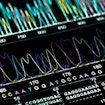
Biological networks provide a natural framework for integrating the diverse genetic variations associated with complex and multifactorial disorders. The main challenge in the analysis of rare genetic variations, such as de novo single nucleotide polymorphisms (SNPs) and copy number variations (CNVs) — duplications or deletions of stretches of DNA — is precisely their rarity. With currently available sample sizes, a vast majority of the observed genetic events are either unique or show only limited recurrency.